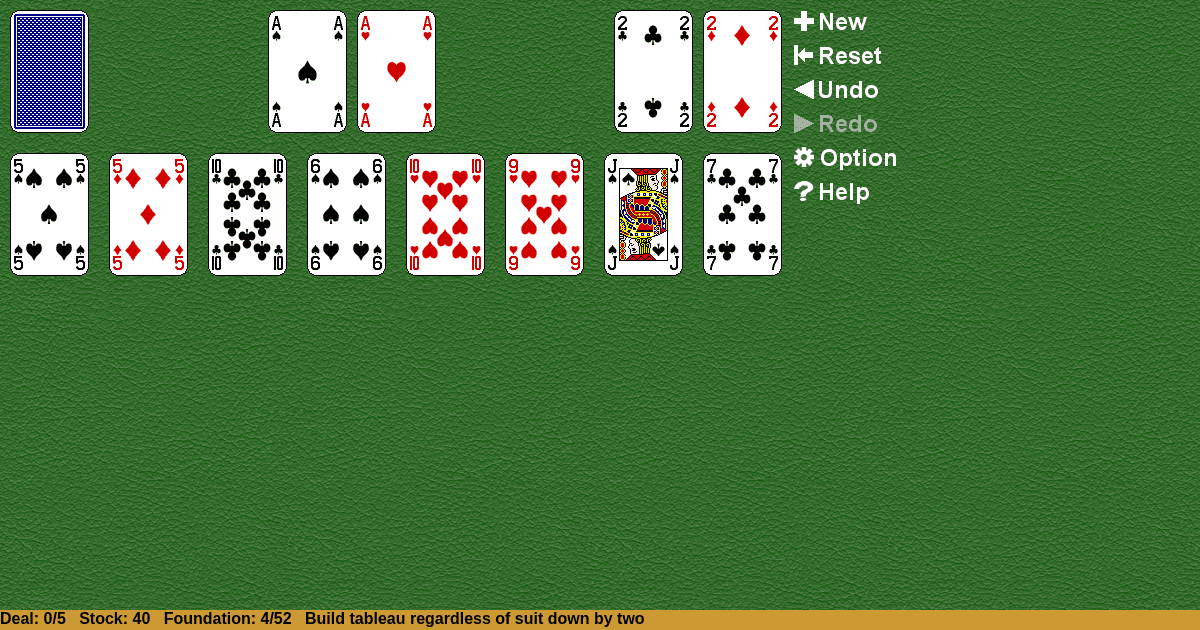Double Dot
Home |
How to play |
FAQ |
About
How to play Double Dot?
Game Objective:
The primary goal in Double Dot Solitaire is to move all 52 cards from the tableau and stock onto the four foundation piles, building each foundation in a specific sequence by suit and in steps of two ranks (either all odd or all even ranks, depending on the foundation).
Setup & Layout:
- Deck: Use one standard 52-card deck.
- Foundations: There are four foundation piles:
- The left two start with an Ace (one from each color).
- The right two start with a Two (one from each color).
- Each foundation pile is dealt its starting card face-up.
- Tableau: Eight tableau columns are created below the foundations.
- Each column receives one card, dealt face-up.
- Stock: The remaining 44 cards form the stock pile, placed face-down.
- Play Areas Defined:
- Foundations: Where cards are built up in suit by twos.
- Tableau: Eight columns for building down by twos.
- Stock: The pile of undealt cards, used to replenish the tableau.
Double Dot Solitaire Rules:
- Foundations:
- Ace Foundations: Build up in suit by odd ranks (Ace, 3, 5, 7, 9, Jack, King, then looping to 2, 4, etc.).
- Two Foundations: Build up in suit by even ranks (Two, 4, 6, 8, 10, Queen, then looping to Ace, 3, etc.).
- Cards must match the suit of the foundation and follow the two-rank step sequence.
- Once placed on a foundation, cards cannot return to the tableau.
- Tableau:
- Cards are built down by twos in rank, regardless of suit (e.g., 6 on 8, Queen on Ace).
- Sequence wrapping is allowed (Queen may be placed on Ace, treating Ace as one below 2 for this purpose).
- Both single cards and valid sequences (built down by twos) can be moved between tableau columns.
- Stock:
- When no more moves are possible, deal one card from the stock onto each tableau pile.
- All tableau columns must contain at least one card or sequence before dealing from the stock.
- The stock can be dealt through only once; there are no redeals.
Gameplay:
- Players move cards within the tableau, building down by twos, and transfer eligible cards to the foundations according to their sequence rules.
- When a tableau column is emptied, any card or valid sequence may be moved into the space—there are no restrictions on filling empty columns.
- If no further moves are available, deal one card from the stock to each tableau column (provided no column is empty).
- Continue alternating between moving cards/sequences and dealing from the stock until all cards are moved to the foundations or no further moves are possible.
Winning & Losing Conditions:
- Win Condition: The game is won when all 52 cards are successfully moved to the foundation piles, each built up in the correct sequence by suit and twos.
- Lose Condition: The game is lost or becomes unwinnable if:
- The stock is exhausted and no further legal moves can be made on the tableau or to the foundations.
- Cards remain in the tableau or stock that cannot be legally played to the foundations.
Special Rules & Edge Cases:
- Filling Empty Tableau Columns: Any card or valid sequence (built down by twos) may be moved to an empty tableau column, providing significant flexibility in rearranging the tableau.
- Dealing from Stock: Before dealing from the stock, ensure that no tableau column is empty; otherwise, dealing is blocked.
- Sequence Wrapping: When building down by twos in the tableau, wrapping from Ace to Queen is permitted (e.g., Queen may be placed on Ace).
- No Redeals: The stock is dealt through only once; after it is exhausted, no further cards can be introduced.
- Immobility of Foundation Cards: Once a card is placed on a foundation, it cannot be moved back to the tableau.
- Suit Matching: Foundations must always be built strictly in suit, while tableau building ignores suit.
Note: Double Dot Solitaire is distinct from the two-player "Double Solitaire" variant and features unique foundation and tableau building rules based on steps of two ranks.

Solitaire Collection
About Double Dot
Rate (Double Dot)
4.7 / 5
1,916 votes



























































